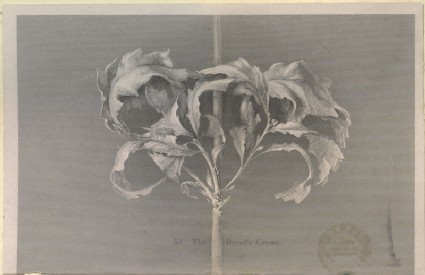Browse: 1470 objects
- Reference URL
Actions
Engraving of John Ruskin's Drawing of the Dryad's Crown: Oak Leaves in Autumn James Charles Armytage
-
Details
- Artist/maker
-
James Charles Armytage (c. 1820 - 1897) (engraver)after John Ruskin (1819 - 1900)
- Object type
- Material and technique
- engraving on wove paper
- Dimensions
- 169 x 261 mm (sheet)
- Inscription
- Recto, within the image, bottom centre, engraved: 53. The Dryad's Crown.
Verso:
along the top edge, in graphite: E. 264 "6. now put present 6 in lower school"
bottom left, the Ruskin School's stamp
- Provenance
-
Presented by John Ruskin to the Ruskin Drawing School (University of Oxford), 1875; transferred from the Ruskin Drawing School to the Ashmolean Museum, c.1949.
- No. of items
- 1
- Accession no.
- WA.RS.ED.264
-
Subject terms allocated by curators:
Subjects
-
References in which this object is cited include:
References
Ruskin, John, Catalogue of the Educational Series (London: Smith, Elder, 1871), cat. Educational no. XI.6
Ruskin, John, Catalogue of the Educational Series (London: Spottiswoode, 1874), cat. Educational no. 264
Ruskin, John, ‘Rudimentary Series 1878’, 1878, Oxford, Oxford University Archives, cat. Rudimentary no. 285
Ruskin, John, ‘The Ruskin Art Collection at Oxford: Catalogues, Notes and Instructions’, Edward T. Cook and Alexander Wedderburn, eds, The Works of John Ruskin: Library Edition, 39 (London: George Allen, 1903-1912), 21, cat. Educational no. 264
Location
-
- Western Art Print Room
Position in Ruskin’s Collection
Ruskin's Catalogues
-
Ruskin's Educational series, 1st ed. (1871)
6 The Dryads’ Crown. Oak leaves in autumn. E -
Ruskin's Educational series, 2nd ed. (1874)
264. The Dryad’s Crown. Oak leaves in autumn. E -
Ruskin's revision to the Rudimentary series (1878)
Edu. 264 285. Dryad’s CrownKnowing thus the facts of structure accurately, the student will proceed to learn their value in Composition by choosing Forms for complete study which can be finished at his leisure. Any group of dried leaves, falling into beautiful arrangements, may be carried home from the Autumnal woods and drawn as carefully as we please. This piece of withered oak falls, as is constantly the case, almost exactly into the form of one of the terminal crockets in the Flamboyant Gothic of the French, which was, indeed, studied entirely from the Autumnal foliage of their forests. I have lost the drawing, to my great regret: but this proof of Mr. Armitage’s beautiful engraving does it more than justice, and deserves most honourable place in our Series as an example of English line-work, imitating even the freest touches of body-colour white in my sketch. A more or less characteristic R. example of the forms of architectural ornament, derived from the withered leaves and entangled or fallen branches of the Woods of Picardy, may be seen in the bracket under the statue of the Madonna, and the door-lintel beneath that, in 289.





